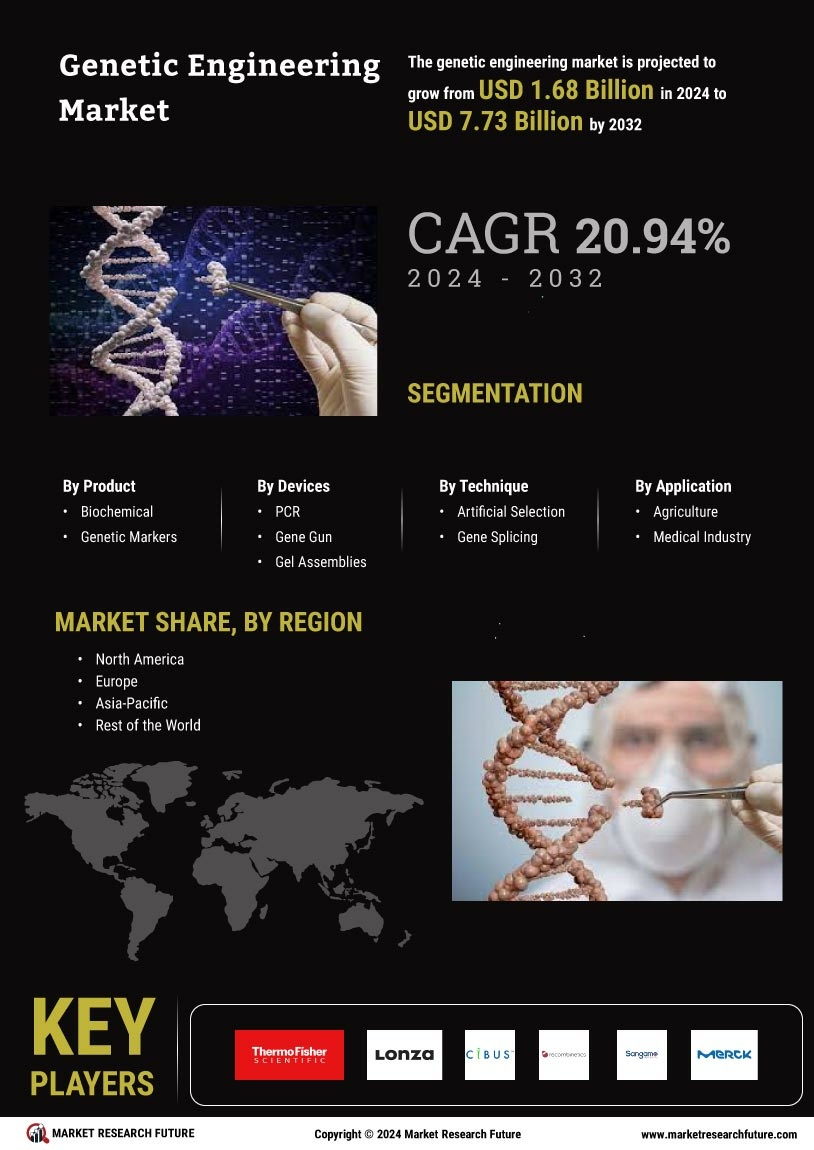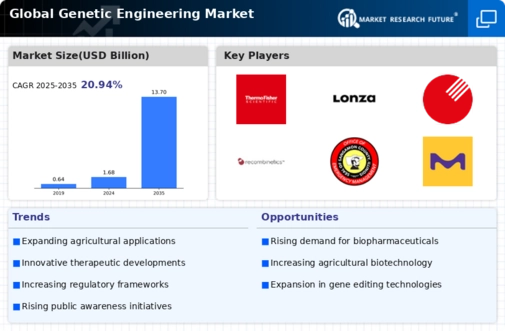Market Growth Projections
The Global Genetic Engineering Market Industry is projected to experience substantial growth over the coming years. The market is valued at approximately 1.68 USD Billion in 2024 and is expected to reach 13.7 USD Billion by 2035. This growth trajectory indicates a compound annual growth rate of 21.0% from 2025 to 2035. Such projections highlight the increasing adoption of genetic engineering technologies across various sectors, including agriculture and medicine. The anticipated expansion of the market underscores the potential for genetic engineering to address global challenges, such as food security and health care advancements.
Regulatory Support for Biotechnology
The Global Genetic Engineering Market Industry benefits from favorable regulatory frameworks that support the development and commercialization of genetically engineered products. Governments worldwide are recognizing the potential of biotechnology to address pressing global challenges, such as food security and environmental sustainability. For example, regulatory agencies are streamlining approval processes for genetically modified organisms, which encourages innovation and investment in the sector. This supportive environment is likely to enhance market growth, as evidenced by the projected increase in market value from 1.68 USD Billion in 2024 to 13.7 USD Billion by 2035, reflecting the growing acceptance of biotechnology in agriculture.
Advancements in Gene Editing Technologies
Innovations in gene editing technologies, such as CRISPR-Cas9, play a pivotal role in shaping the Global Genetic Engineering Market Industry. These advancements enable precise modifications to DNA, facilitating the development of crops with desirable traits. The efficiency and accuracy of these technologies have led to their widespread adoption in research and commercial applications. As a result, the market is likely to witness a compound annual growth rate of 21.0% from 2025 to 2035. This growth is indicative of the increasing investment in research and development, as well as the potential for gene editing to revolutionize agriculture and medicine.
Growing Awareness of Sustainable Practices
The Global Genetic Engineering Market Industry is increasingly influenced by the growing awareness of sustainable agricultural practices. Consumers and farmers are becoming more conscious of the environmental impact of traditional farming methods, leading to a shift towards biotechnology solutions that promote sustainability. Genetically modified crops can reduce the need for chemical pesticides and fertilizers, thereby minimizing environmental harm. This trend aligns with global efforts to achieve sustainable development goals, potentially driving market growth. The market's value is expected to rise from 1.68 USD Billion in 2024 to 13.7 USD Billion by 2035, reflecting the increasing demand for sustainable agricultural practices.
Rising Demand for Genetically Modified Crops
The Global Genetic Engineering Market Industry experiences a surge in demand for genetically modified crops, driven by the need for increased agricultural productivity. As the global population continues to grow, the pressure on food supply intensifies. Genetically modified crops offer enhanced resistance to pests and diseases, which can lead to higher yields. For instance, in 2024, the market is valued at approximately 1.68 USD Billion, reflecting the increasing adoption of biotechnology in agriculture. This trend is expected to continue as farmers seek sustainable solutions to meet food security challenges, potentially contributing to the projected growth of the market to 13.7 USD Billion by 2035.
Increased Investment in Agricultural Biotechnology
Investment in agricultural biotechnology is a significant driver of the Global Genetic Engineering Market Industry. Stakeholders, including governments, private companies, and research institutions, are channeling resources into developing innovative solutions for crop improvement. This influx of capital supports research initiatives and the commercialization of genetically modified crops. As a result, the market is poised for substantial growth, with projections indicating a rise from 1.68 USD Billion in 2024 to 13.7 USD Billion by 2035. The anticipated compound annual growth rate of 21.0% from 2025 to 2035 underscores the potential for biotechnology to transform agricultural practices and enhance food production.





















Leave a Comment